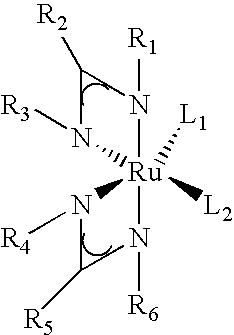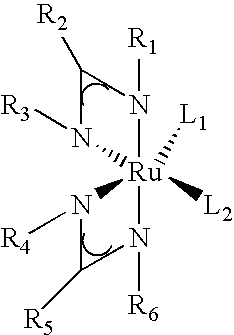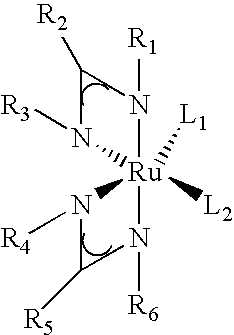Processes for the production of organometallic compounds
a technology of amidinate and compounds, which is applied in the direction of organic chemistry, ruthenium organic compounds, iron organic compounds, etc., can solve the problems of reduced surface area to volume ratio of interconnection, increased difficulty in detecting and detecting tantalum metals, and inability to deposit tantalum metals using atomic layer deposition. , to achieve the effect of improving morphology, improving thermal stability, and less diffusion
- Summary
- Abstract
- Description
- Claims
- Application Information
AI Technical Summary
Benefits of technology
Problems solved by technology
Method used
Image
Examples
example 1
[0088] Synthesis of lithium (N,N′-diisopropylacetamidinate)
[0089] A dry 500 milliliter 3-neck round-bottom flask was equipped with a 100 milliliter dropping funnel, a Teflon stir bar, and a thermocouple. The system was connected to an inert atmosphere (N2) nitrogen manifold and the remaining outlets were sealed with rubber septa. To this flask was added 155 milliliters of tetrahydrofuran (THF) and 13.99 grams of diisopropylcarbodiimide. The solution was cooled to −50° C. by use of a dry ice / acetone bath. 72 milliliters of 1.6 M MeLi in diethyl ether was added to the dropping funnel. The MeLi solution was added dropwise to the diisopropylcarbodiimide solution at a rate sufficiently slow to keep the temperature of the solution below −30° C. Following the addition the solution was allowed to warm to room temperature overnight. The pale yellow solution can be used either as a solution of lithium (N,N′-diisopropylacetamidinate) or the solvent can be removed to isolate the salt.
[0090] S...
PUM
| Property | Measurement | Unit |
|---|---|---|
| temperatures | aaaaa | aaaaa |
| temperature | aaaaa | aaaaa |
| temperature | aaaaa | aaaaa |
Abstract
Description
Claims
Application Information
 Login to View More
Login to View More - R&D
- Intellectual Property
- Life Sciences
- Materials
- Tech Scout
- Unparalleled Data Quality
- Higher Quality Content
- 60% Fewer Hallucinations
Browse by: Latest US Patents, China's latest patents, Technical Efficacy Thesaurus, Application Domain, Technology Topic, Popular Technical Reports.
© 2025 PatSnap. All rights reserved.Legal|Privacy policy|Modern Slavery Act Transparency Statement|Sitemap|About US| Contact US: help@patsnap.com



